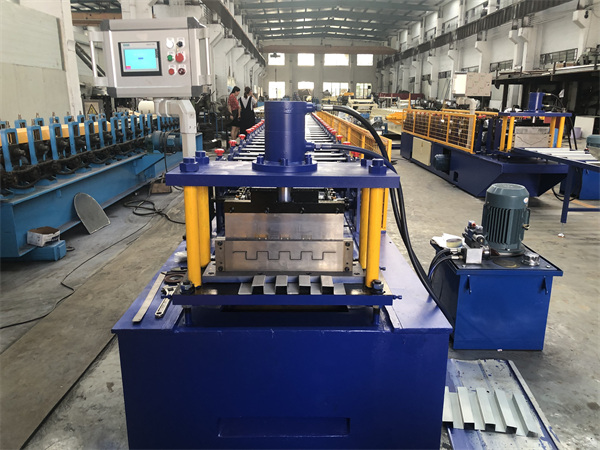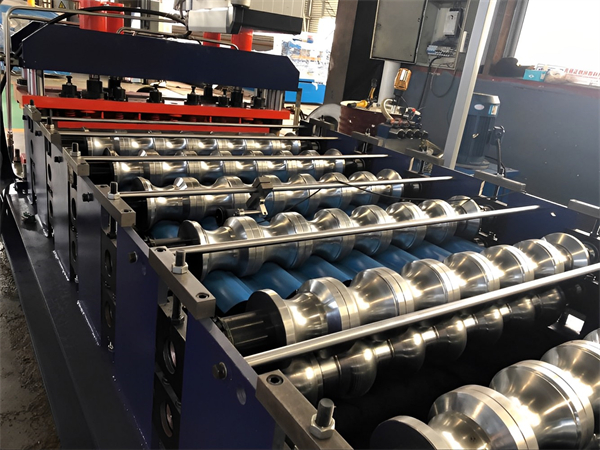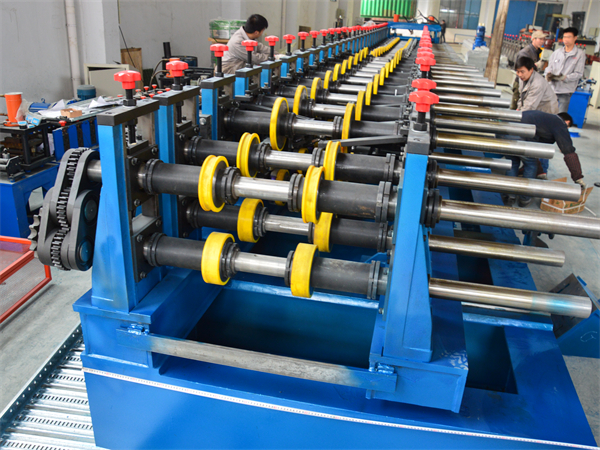Rulo şekillendirme, sabit kesitli uzun saclar veya profiller üretmek için kullanılan bir metal şekillendirme işlemidir. A rulo şekillendirme makinesi sac veya şeritleri bir dizi silindir kalıp aracılığıyla aşamalı olarak şekillendirir. Proses, yüksek hacimli standartlaştırılmış parçalar üretmek için çok yönlü, verimli ve ekonomiktir. Bu kılavuz, rulo şekillendirme makinesi tipleri, temel bileşenler, teknik özellikler ve seçim, çalıştırma ve bakım için en iyi uygulamalar hakkında ayrıntılı bir genel bakış sağlar.
Rulo Şekillendirme Süreci ve Makinelerine Genel Bakış
Rulo şekillendirme makineleri, çeşitli profiller ve kesitler üretmek için farklı konfigürasyonlarda mevcuttur. Merdane kalıpları, profili kademeli olarak şekillendirmek için birbirini takip eden standlardan geçerken malzemeyi kademeli olarak büker. Temel hususlar şunlardır:
Rulo Şekillendirme Makinesi Çeşitleri
| Makine Tipi | Açıklama |
|---|---|
| Tek Kişilik Profil | Sürekli tek profil üretir |
| Çoklu Profil | Farklı profiller için değiştirilebilir başlıklar |
| Taşınabilir | Yerinde veya mobil çalışma için kompakt |
| Özel | Özel profiller için uyarlanmıştır |
Rulo Şekillendirme Makinesi Bileşenleri:
- Makaralı kalıplar - Levhayı kademeli olarak bükmek için birbirini takip eden standlar halinde şekillendirilir
- Şekillendirme istasyonları - Sıralı bükme için makaralı kalıplar
- Açıcı - Ham bobin malzemesini makineye besler
- Besleme mekanizması - Malzeme besleme hızını ve gerginliğini kontrol eder
- Silindirler - Destek sağlar ve malzeme akışını yapılandırır
- Kesme cihazı - Bitmiş profilleri boyuna keser
Rulo Şekillendirme Makinesi Özellikleri
Rulo şekillendirme ekipmanlarının teknik özellikleri, kapasitelerini ve üretim kapasitelerini belirler. Dikkate alınması gereken temel parametreler şunlardır:
Rulo Şekillendirme Makinesi Tasarım Özellikleri:
| Şartname | Detaylar |
|---|---|
| Yuvarlanma Uzunluğu | Silindirlerin uzunluğu ve maksimum profil uzunluğu |
| Yuvarlanma Genişliği | Silindirler arası genişlik ve maksimum malzeme genişliği |
| Haddeleme Kalınlığı | Desteklenen hammadde kalınlık aralığı |
| Şekillendirme İstasyonları | Kademeli bükme için stand sayısı |
| Makara Boyutu | Silindirlerin çapı ve genişliği |
| Makara Malzemesi | Çelik, alaşımlı çelik vb. |
| Makaralı Tip | Yatay, dikey, eğimli, piramit vb. |
| Sürücü Tipi | Elektrikli, hidrolik, servo, kombinasyon |
| Hız Aralığı | Minimum ve maksimum yuvarlanma hızı |
| Yem Sistemi | Açıcı, besleme ruloları, sıkıştırma ruloları vb. |
| Kesme Modu | Kesme, testere, lazer kesim vb. |
| Aletler | Hızlı değişim, modüler, özel vb. |
| Otomasyon | PLC kontrolleri, hareket kontrolleri, sensörler vb. |
Performans Özellikleri:
| Parametre | Tipik Değerler |
|---|---|
| Yuvarlanma Hızı | 10 - 100 m/dak |
| Üretim Oranı | 120 m/dak'ya kadar |
| Doğruluk | 3 m uzunluk üzerinde ±0,5 mm |
| Tekrarlanabilirlik | Progresif kalıplar sayesinde mükemmel |
| Yüzey İşlemi | Pürüzsüz, kesimde izler olabilir |
Operasyonel Gereksinimler:
| Öğe | Detaylar |
|---|---|
| Güç | 20-100 kW bağlı yük |
| Hava Basıncı | Pnömatik için 5-8 bar |
| Personel | 1-2 yarı vasıflı operatör |
| Uzay | Uzunluk > 15m. Genişlik > 4m, Yükseklik > 3m |
Spesifikasyonlar profile, malzemelere ve üretim hacimlerine bağlı olarak büyük ölçüde değişir. Özel gereksinimlere uyacak şekilde özel makineler üretilebilir.

Rulo Şekillendirme Makinesi Tasarımı ve Çalışması
Rulo şekillendirme makinelerinin tasarım yönleri ve çalışma prensibi:
Makine Yapısı
- Sertlik için ağır taban çerçevesi
- Şekillendirme istasyonları için baş üstü destek standı
- Malzeme akışı için hat içi yapılandırma
- Erişilebilirlik için yanal veya dikey bölünmüş muhafaza
Merdane Kalıpları
- İşlenmiş alaşımlı çelikten yapılmıştır
- Şekillendirme standlarında şaftlara monte edilir
- Yatay, dikey veya açılı olarak düzenlenmiş
- Yakın toleranslara göre taşlanmış ve sertleştirilmiş
- Esnek üretim için hızlı değişim tasarımı
Şekillendirme İstasyonları
- Üst ve alt silindirlerin ev kombinasyonu
- Rulmanlar üzerine monte edilmiş makaralı miller
- Ayarlanabilir makara bağlantıları ve ara parçalar
- Hassas kalıp konumlandırma için kılavuz raylar
Yem Sistemi
- Başlangıçta açıcı veya tabaka besleyici
- Hız kontrolü için servo motorlar ve sürücüler
- Kayma olmadan pozitif kavrama için kıstırma ruloları
- Ağ gerginliğini korumak için dansçı kolu
- Deformasyonu önlemek için anti-fitilleme ruloları
Sürücüler
- Elektrikli servo motorlar ve sürücüler
- Yüksek tork için hidrolik tahrikler
- Hassas hız ve gerginlik kontrolü
- Makaralı miller için bağımsız tahrikler
- Ana kodlayıcı kullanılarak senkronize edilir
Kontrol Sistemi
- PLC veya endüstriyel PC kontrolü
- Arayüz için HMI dokunmatik ekran
- Rulo boşluğu ve hız ayarları
- Servo sürücü senkronizasyonu
- Güvenlik kilitleri ve otomatik durdurma
Çalışma Prensibi
- Rulo kalıplara beslenen sac veya bobin
- Progresif bükülme adımlar halinde gerçekleşir
- Alt silindirler karşı kuvvet sağlar
- Bitmiş profil ile çıkan malzeme
- Testere veya makasla boyuna kesilmiş
Hassas bir şekilde işlenmiş silindir kalıplarının koordineli hareketi sayesinde, şerit malzeme rulo şekillendirme işlemi ile kademeli olarak istenen enine kesite göre şekillendirilir.
Rulo Şekillendirme Operasyonu
| Adım | Operasyon |
|---|---|
| 1 | Besleme rulolarına beslenen bobin stoğu |
| 2 | Merdaneli kalıplarla aşamalı olarak şekillendirilen malzeme |
| 3 | Alt silindirler karşı kuvvet sağlar |
| 4 | Profil oluşturma aşamalı olarak gerçekleştirilir |
| 5 | Şekillendirilmiş bölüm makine boyunca akar |
| 6 | Kesme cihazı bitmiş profili keser |
Uygulamalar ve Hizmet Verilen Sektörler
Sürekli üretim, hafiflik, yüksek mukavemet ve korozyon direnci nedeniyle haddelenmiş profiller endüstrilerde yaygın kullanım alanı bulmaktadır.
Rulo Şekillendirilmiş Ürünlerin Uygulama Alanları:
| Kategori | Ürünler |
|---|---|
| Yapısal profiller | Çatı kaplama levhaları, duvar panelleri, astar tepsileri, saplamalar, kirişler, kirişler |
| Depolama ürünleri | Raflar, raflar, dolaplar, gardıroplar |
| Mobilya parçaları | Çerçeveler, muhafazalar, raflar, ayaklar |
| Otomotiv parçaları | Döşeme, sızdırmazlık, tamponlar, tavan rayları, borular |
| Aletler | Paneller, muhafazalar, sargılar, çerçeveler |
| HVAC kanalları | Dikdörtgen ve spiral kanallar |
| Tarımsal binalar | Kaplama, çatı kaplama, yapısal çerçeveler |
Sektörel Uygulamalar
| Endüstri | Uygulama Ürünleri |
|---|---|
| Bina ve İnşaat | Kaplama, zemin kaplaması, aşıklar, çatı kaplaması, kapılar, korkuluklar |
| Otomotiv ve Taşımacılık | Gövde panelleri, tavan rayları, koltuk çerçeveleri, tamponlar |
| Elektrik ve Elektronik | Muhafaza panelleri, şasiler, dağıtım kutuları |
| Tüketici Aletleri | Çamaşır makinesi tamburları, buzdolabı gömlekleri, dış paneller |
| Havalandırma ve İklimlendirme | Spiral kanallar ve bağlantı parçaları, duman egzozları |
| Altyapı | Korkuluklar, aydınlatma direkleri, tabelalar, güneş çerçeveleri |
| Mobilya | Dolap kapakları, masa ayakları, raflar, depolama rafları |
Rulo şekillendirilmiş profiller, endüstriyel ve ticari uygulamalarda hafif, yüksek mukavemetli yapılar sağlar.
Rulo Şekillendirme İşleminin Faydaları ve Avantajları
Rulo şekillendirme, diğer şekillendirme yöntemlerine kıyasla önemli avantajlar sunar:
Rulo Şekillendirmenin Faydaları
| Parametre | Avantajlar |
|---|---|
| Sermaye Maliyeti | Damgalama veya abkant preslerden daha düşük |
| İşletme Maliyeti | Düşük güç tüketimi, minimum israf |
| Üretim Oranı | Manuel yöntemlere göre 10 kata kadar daha hızlı |
| İşgücü | Yarı vasıflı operatörler gerektirir |
| Değişimler | Silindir kalıplar hızlı profil geçişlerine olanak sağlar |
| Esneklik | Boyutları ve malzemeleri değiştirmek kolaydır |
| Doğruluk | Tutarlı ve tekrarlanabilir profiller |
| Yüzey İşlemi | Pürüzsüz, parlak yüzey mümkün |
| Güç | Soğuk şekillendirme metali sertleştirir |
| Hafif | İnce ve daha hafif yapılar mümkün |
| Basit İşlemler | Kullanıcı dostu kontroller ve otomasyon |
| Güvenlik | İyi korunmuş hareketli parçalar |
Rulo şekillendirmenin benimsenmesini sağlayan temel faktörler arasında yüksek üretkenlik, esneklik, üstün kalite ve maliyet verimliliği yer almaktadır.

Rulo Şekillendirme Makinesi Çeşitleri
Rulo şekillendirme makineleri, özel üretim ihtiyaçları için tasarlanmış farklı konfigürasyonlarda mevcuttur:
Rulo Şekillendirme Makinesi Çeşitleri
| Makine | Açıklama |
|---|---|
| Boylamasına Hat | Yüksek hacimli panel üretimi için |
| Portatif Rollformer | Hafif ve mobil çalışma |
| Çok Profilli Makine | Hızlı profil değişimi |
| Çift Kafa Rollformer | Daha yüksek üretim oranları |
| Piramit Tipi | Çift yönlü şekillendirme özelliği |
| Özel Rollformer | Özel profiller için tasarlandı |
Boylamasına Hat
- Inline üretim hattı
- Açıcı, akümülatör, şekillendirme değirmenleri, kesme
- 25 m üzeri uzunluklar
- Parça deposu entegrasyonu
- Yüksek hacimli levha üretimi için
Portatif Rollformer
- Kompakt ve taşınabilir
- Römork veya kamyona monte
- Yerinde üretim için
- Esnek konumlandırma
- Daha düşük kapasite
Çok Profilli Makine
- Bilgisayar kontrollü istasyonlar
- Hızlı kalıp değişimi
- Önceden yüklenmiş çoklu profiller
- Daha düşük hacimli esneklik için
Çift Kafa Rollformer
- Yan yana iki şekillendirme hattı
- Bağımsız hız kontrolü
- Daha yüksek üretim oranı
- Çalışma süresi için yedeklilik
Piramit Tipi
- Çift yönlü silindir konfigürasyonu
- Şekillendirme sırasında daha iyi destek
- Parça bükülmesini önler
- Simetrik kesitler için
Özel Rollformer
- Benzersiz profil için tasarlandı
- Özel makara tasarımı
- Özel üretim
- Özel bölümler için
Seçim, gerekli verim, profil karmaşıklığı, değişim ihtiyaçları ve üretim hacimlerine bağlıdır.
Rulo Şekillendirme Makinesi Nasıl Seçilir
Bir rulo şekillendirme makinesi seçerken göz önünde bulundurulması gereken temel faktörler şunlardır:
Rulo Şekillendirme Makinesi Seçim Kriterleri
| Parametre | Dikkate Alınması Gerekenler |
|---|---|
| Profil şekli | Boyutsal özellikler, yarıçaplar, açılar |
| Malzeme | Çelik, alüminyum kaliteleri ve kalınlıkları |
| Üretim oranı | Saatlik veya yıllık hacim gerekli |
| Uzunluk | İhtiyaç duyulan maksimum parça uzunluğu |
| Genişlik | Mevcut çalışma genişliği ve alanı |
| Aletler | Standart veya özel rulo kalıpları |
| Kontroller | Programlama ve ayar kolaylığı |
| Otomasyon seviyesi | Malzeme taşıma ve hız kontrolü |
| Hat düzeni | Sıralı veya enine düzenleme |
| Performans | Hız, hassasiyet, yüzey kalitesi |
| Güvenlik | Koruma, acil durdurma |
Kritik Faktörler
- Tüm özellikleri içeren profil çizimleri
- Yıllık veya günlük üretim hacmi
- Günlük çalışma vardiyaları
- Hammadde tipi ve kalınlığı
- Doğruluk ve bitiş gereksinimleri
- Makine için kullanılabilir alan
- Operatör beceri seviyesi
- Gelecek için genişletilebilirlik
Makineleri ilk kez veya büyük üretim ölçeği için belirlerken rulo şekillendirme uzmanlarına danışılması şiddetle tavsiye edilir. Gereksinimleri doğru belirlemek, üretkenliği ve toplam sahip olma maliyetini en üst düzeye çıkarmanın anahtarıdır.
Rulo Şekillendirme Makinesi Üreticileri
Rulo şekillendirme ekipmanlarının önde gelen küresel üreticilerinden bazıları şunlardır:
Başlıca Rulo Şekillendirme Makinesi Üreticileri
| Şirket | Konum |
|---|---|
| Bradbury Grup | ABD |
| Formtek | ABD |
| Gasparini SpA | İtalya |
| Hangzhou Rulo Şekillendirme Makineleri | Çin |
| Howick Ltd. | Yeni Zelanda |
| Metform | Türkiye |
| Robor Corp | ABD |
| Rollvis SA | İsviçre |
| Form Süreç Mühendisliği | Hindistan |
Kapasiteler ve Modeller
- 180 m/dak'ya kadar üretim
- 2,5 m'ye kadar genişlik
- Hızlı kalıp değiştirme modüler standları
- Tek, çift ve çok profilli makineler
- Standart ve özel roll former tasarımları
Rulo şekillendirme makineleri tedarik ederken, teklif veren üreticileri göz önünde bulundurun:
- Geniş model yelpazesi ve özelleştirme
- Yerel satış ve servis desteği
- En son teknoloji ve özellikler
- Eğitim ve bakım programları
- Genel yaşam döngüsü değeri ve TCO
Köklü bir üreticinin seçilmesi, makinenin kullanım ömrü boyunca servis, parça, yükseltme ve süreç desteğine erişim sağlayabilir.
Rulo Şekillendirme Makinesi Fiyatlandırması
Rulo şekillendirme makinesi fiyatları, makineye göre değişmektedir:
Maliyeti Etkileyen Faktörler
- Tip ve boyut
- Üretim hızı
- Otomasyon özellikleri
- Kontroller ve sürücüler
- Malzeme kalınlığı kapasitesi
- Kalıp tasarımı
- Üreticinin markası ve yeri
Tipik Maliyet Aralıkları
| Makine Tipi | Fiyat Aralığı |
|---|---|
| Giriş seviyesi taşınabilir | $40,000 ila $100,000 |
| Tek profilli makineler | $100,000 ila $500,000 |
| Çok profilli makineler | $250,000 ila $1 Milyon |
| Yüksek hızlı uzunlamasına hatlar | > $1 Milyon |
| Özel rulo şekillendiriciler | Uygulamaya bağlı |
Ek Maliyet Kalemleri
- Tasarım mühendisliği ücretleri
- Profil için kalıp maliyeti
- Nakliye ve gümrük
- Kurulum ve devreye alma
- Operatörler için eğitim
- Yedek parça envanteri
Depo entegrasyonu, otomasyon ve özel özelliklere sahip büyük üretim hatlarının maliyeti $2 milyonun üzerinde olabilir. Farklı tedarikçilerden teklif alınması tavsiye edilir.

Rulo Şekillendirme Makineleri Nasıl Çalıştırılır ve Bakımı Nasıl Yapılır
Rulo şekillendirme makinelerinin üretkenliği ve uzun ömürlü olması için doğru çalıştırma ve önleyici bakım şarttır:
Rulo Şekillendirme Makinesi Çalışması
| Etkinlik | Açıklama |
|---|---|
| Planlama | Üretimi planlamak, malzeme bulunabilirliğini sağlamak |
| Teftiş | Silindirleri, güvenlik cihazlarını, yağlamayı kontrol edin |
| Programlama | Doğru profili, hızı, uzunluğu girin |
| Kurulum | Konum kılavuzları, kesici uçlar, kesme |
| Jog modu | Daha düşük hızda test çalıştırması için inç |
| Koşmak | Şekillendirme, hız, sensörlerin izlenmesi |
| Kalite | İlk parçanın boyutsal doğruluğunu teyit edin |
| Güvenlik | Korumaların yerinde olduğundan ve güvenli olmayan koşulların bulunmadığından emin olun |
- Sac metalle çalışırken eldiven ve koruyucu gözlük kullanın
- Makine parametrelerini kademeli ve sistematik olarak ayarlayın
- Kaymaları önlemek için yağ döküntülerini derhal temizleyin
- Anormal gürültü, titreşim veya davranışları bildirin
Bakım Kontrolleri
| Sistem | Bakım Görevleri | Frekans |
|---|---|---|
| Silindirler | Yüzey hasarını inceleyin | Haftalık |
| Rulmanlar | Makaralı mil yataklarını yağlayın | Aylık |
| Sürücüler | Kayış gerginliğini ve hizalamasını kontrol edin | Aylık |
| Muhafızlar | Yerinde ve işlevsel olduğundan emin olun | Günlük |
| Hidrolik | Yağ seviyesini ve sızıntıları kontrol edin | Aylık |
| Elektrik | Bağlantıları, kapakları inceleyin | Üç Aylık |
| Yapı | Gevşek bağlantı elemanlarını kontrol edin | Aylık |
| Güvenlik | Acil durdurmaları ve sensörleri test edin | Üç Aylık |
Üreticinin tavsiyelerine göre proaktif bakım, maksimum çalışma süresi ve makine ömrünün uzatılması için hayati önem taşır. Tüm denetimlerin, onarımların ve parça değişimlerinin kayıtlarını tutun.
Rulo Şekillendirme Güvenlik İpuçları
Rulo şekillendirme işlemleri, güvenlik önlemleri gerektiren hareketli makineler ve sac metal taşıma işlemlerini içerir:
- Erişimi sadece eğitimli personel için kısıtlayın
- Uygun makine korumasının yerinde olduğundan emin olun
- Çalışma sırasında asla güvenli olmayan alanlara uzanmayın
- Bakımdan önce kilitleme prosedürlerini izleyin
- Sac metalle çalışırken kesilmeye dayanıklı eldivenler giyin
- Çalışma alanını temiz ve düzenli tutun
- Asla malzeme akış yolu hizasında durmayın
- Üretim alanında yeterli aydınlatmanın sağlanması
- Acil durdurma düğmesi konumlarını bilin
- Güvenli olmayan elektrik, mekanik veya hidrolik koşulları bildirin
- Güvenlik mekanizmalarını asla değiştirmeyin veya geçersiz kılmayın
- Güvenlik prosedürlerini ve eğitimini resmileştirin
Güvenliği bir öncelik haline getirmek, haddeleme işlemleri sırasında personeli ve ekipmanı korur.
Rulo Şekillendirme Makinesi Sorun Giderme
Rulo şekillendirme makinelerinde karşılaşılan bazı yaygın sorunlar ve çözümleri şunlardır:
Rulo Şekillendirme Sorunları ve Çözümleri
| Sorun | Olası Nedenler | Düzeltici Faaliyetler |
|---|---|---|
| Yanlış profil | Aşınmış makaralar, gevşek şaftlar | Silindirleri yeniden hizalayın/değiştirin, milleri sıkın |
| Çizilmiş yüzey | Enkaz, hasarlı silindirler | Silindirleri temizleyin, hasarlı olanları değiştirin |
| Aşırı titreşim | Dengesizlik, gevşek parçalar | Gevşek parçaları sıkın, silindirleri yeniden dengeleyin |
| Hidrolik sızıntılar | Aşınmış contalar, hasarlı hortumlar | Contaları, hasarlı hortumları değiştirin |
| Hız değişimi | Kayma kayışları, sensör sorunu | Kayış gerginliğini ayarlayın, sensörü kontrol edin |
| Düzensiz malzeme beslemesi | Aşınmış/kaygan besleme silindirleri | Besleme silindirlerini değiştirin, gerginliği artırın |
| Yaprak sıkışması | Yanlış hizalanmış kılavuzlar, aşınmış makaralar | Kılavuzları yeniden hizalayın, aşınmış makaraları değiştirin |
Arızalar giderilemiyorsa makine kılavuzuna ve üreticiye danışın. Herhangi bir güvenlik sorunu durumunda çalışmayı derhal durdurun.
Rulo Şekillendirme Makinesi SSS
S: Hangi malzemeler rulo şeklinde şekillendirilebilir?
C: Çelik, paslanmaz çelik, alüminyum, bakır, pirinç gibi çoğu sünek metal. 3 mm'nin altındaki kalınlıklar yaygındır.
S: Hangi profil şekilleri mümkündür?
A: C, U, Z, şapka, boru, açı, kanal, raylar, çubuklar vb. Karmaşık boncuklar ve panjurlar da mümkündür.
S: Üretim oranı nasıl hesaplanır?
A: ft/dk cinsinden üretim hızı = Makine hızı (ft/dk) x Kafa sayısı
S: Hangi toleranslara ulaşılabilir?
A: 3 m uzunluk üzerinde +/- 0,5 mm tipiktir. Hassas makaralarla daha dar toleranslar mümkündür.
S: Kaç operatöre ihtiyaç var?
C: Tipik operasyon için 1-2 operatör. Otomatik hatlarda hiç gerekmeyebilir.
S: Rulo şekillendirmeden sonra yüzey kaplaması mümkün mü?
C: Evet, toz boya ve diğer kaplamalar rulo şekillendirmeden sonra uygulanabilir.
